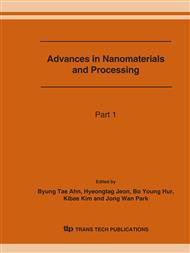p.1809
p.1813
p.1817
p.1821
p.1825
p.1829
p.1833
p.1837
p.1841
Structural Features and Microwave Properties of Ba0.5Sr0.5TiO3 Films Grown on Sapphire Substrates
Abstract:
The change in dielectric constant of ferroelectric materials as a function of electric field is the key to wide range of microwave application such as tunable filter, impedance matching network, and phase shifter. In this study, ferroelectric Ba0.5Sr0.5TiO3 (BST) films were grown on r-cut sapphire and polycrystalline sapphire (poly-sapphire) substrates by RF sputtering. The results of comprehensive structural diagnostics of the films are correlated with the dielectric constant and dielectric loss of a co-planar BST varactor, measured at a frequency range of 1~3 GHz. Textured BST films approximately 500 nm thick, grown on r-cut sapphire substrates, are characterized by high dielectric constant ≥ 650. However, polycrystalline BST films, grown on poly-sapphire substrates, are less strained, having dielectric constant range of 430 ~ 640.
Info:
Periodical:
Pages:
1829-1832
Citation:
Online since:
June 2007
Price:
Сopyright:
© 2007 Trans Tech Publications Ltd. All Rights Reserved
Share:
Citation:


